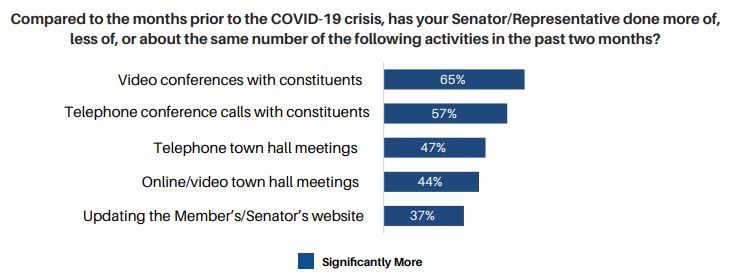
Source: 2020 survey of House and Senate senior staff, published in The Future of Citizen Engagement: Coronavirus, Congress, and Constituent Communications, Congressional Management Foundation, 2020.
A mid-21st century Congress
The SCOMC envisioned an institution that reclaims its Article I power and prerogatives, invests in its talent and technology, and nurtures a culture of civility and bipartisanship. Radical steps are required to get there, but the SCOMC has created a roadmap for the journey. Its final report made 97 recommendations in 15 categories. A resolution adopting the first 29 passed the full House overwhelming in March 2020, an unusual bipartisan endorsement of change. The House is expected to act on the remaining recommendations soon.
Here are a few of its 97 ideas: Streamlined bill-writing, public tracking of amendments, better public information about lobbyists and lobbying, one-click access to see how Members of Congress vote in committee, and more flexible working conditions, including telework.
The SCOMC also endorsed bipartisan solutions to thorny issues such as the Congressional calendar, raising staff salaries, and revamping staffing and procedures in committees. In its final months, the SCOMC even passed recommendations for reforming the budget and appropriations process and creating a new program for Congress to direct federal spending for local community projects, replacing the abandoned “earmarks” system.
What’s next?
It’s likely the House will vote before the end of 2020 on another set of SCOMC recommendations. When approved, some recommendations will be referred to standing committees for further actions, while others could be implemented without legislation by House Leadership or the Committee on House Administration. It’s also possible the House may vote to set up another kind of Modernization Committee to continue developing proposals.
Meanwhile, the Hewlett grantee organizations who regularly shared information, strategies and resources in support of the SCOMC are now exploring how to support modernization in the Senate. The Senate is organized differently than the House, but it similarly suffers from lags in adopting technology tools, lack of strong, centralized human resources and career development support, and uncertainty over how and when to permit remote operations under its rules.
Like the House, initial Senate opposition to remote operations dissipated in the face of necessity. Far from being relegated to only low-priority matters, a hybrid model of in-person and remote participation has already been used for one of the most monumental Senate responsibilities: confirmation hearings for a Supreme Court Justice. And the majority of Senate staff members have been working from home for months.
Members and staff are discovering that certain kinds of modernization forced by the pandemic and encouraged by the thoughtful, bipartisan institutional efforts of the Select Committee on the Modernization of Congress will remake the 21st century Congress faster than anyone imagined two years ago. What course that will take, and how fast, will be front-and-center for the 117th Congress.
